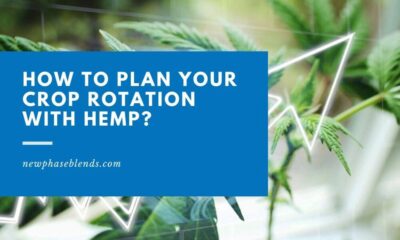Hemp is the perfect plant for crop rotations. This is the process of rotating crops during a farming season to return plant nutrients to the soil without the use of synthetic fertilizers. For example, a farmer can grow one crop this year and change to another crop during the next year. This process also stifles plant disease and pest cycles, improving the soil’s nutrient content and bolstering the farm’s biodiversity.
Hemp Crop Rotations Explained
Hemp is a superstar in the world of farming, offering two huge benefits.
- First, hemp is a fantastic cover crop that protects soil from erosion and leaching. The hemp plant gives back to the soil after using its nutrients, making it a sustainable crop.
- Second, industrial hemp can be a good source of revenue for farmers and can be sold for cannabidiol (CBD) oil production.
Like hemp cultivation, the process of rotating crops has been around for a long time. It was born out of the need for farmers to increase the fertility of their fields and crop yields.
Crop rotation uses the give and takes mechanism of some plants to break the cycle of diseases and improve soil structure and biomass due to the diverse rooting systems of the crops planted. It is a sustainable way of keeping soil healthy without the use of toxic chemicals.
Hemp’s rapid growth (it takes roughly three months for hemp to be ready for harvest) makes it perfect as a counterbalance for many major crops.
Research on Including Hemp in Your Rotation
Recent research has revealed that crop rotation could be your best friend. According to an article in Agronomy titled China’s Heilongjiang Academy of Agricultural Sciences (2022), rotating hemp with other crops can significantly boost yields while naturally fighting off diseases.
The researchers tested three different rotation systems over three years:
- Hemp → Watermelon → Hemp
- Hemp → Potato → Hemp
- Hemp → Bean → Hemp
Compared to growing hemp continuously (monoculture), all three rotation systems showed impressive benefits:
The rotated hemp plants were healthier, taller, and produced better yields of both flowers and leaves. Most importantly, they showed much lower rates of fusarium wilt, a destructive fungal disease that can devastate hemp crops. What’s particularly interesting is why this works – it all comes down to soil health.
The study found that rotating crops helps maintain a diverse and balanced community of soil microorganisms. When hemp is grown continuously in the same soil, beneficial bacteria and fungi decrease while harmful pathogens increase. But rotation helps break this cycle, promoting beneficial soil organisms that naturally suppress diseases while improving nutrient availability.
The key takeaway for hemp farmers? Don’t grow hemp in the same field year after year. Instead, rotate it with other crops like watermelon, potatoes, or beans. This simple change can lead to:
- Healthier plants with better disease resistance
- Improved soil quality
- Higher yields of both flowers and leaves
- More sustainable long-term production
While all three rotation systems tested were effective, any rotation appears better than no rotation at all. This research suggests that crop rotation isn’t just an old farming tradition – it’s a scientifically-proven strategy for more successful and sustainable hemp cultivation.
Why Should You Follow a Crop Rotation with Hemp?
Throughout much of the 20th century, hemp cultivation was illegal in the US and many parts of the world due to its association with marijuana and its psychoactive properties.
These factors and more led to a ban on the cultivation, use, and distribution of marijuana.
All this changed with the passing of the 2018 Farm Bill, which allowed for the broad cultivation of hemp and transfer of hemp-derived products across state lines. However, there are still restrictions in place, one being that industrial hemp flowers cannot contain more than 0.3% THC.
Today, more farmers are showing a greater interest in industrial hemp, both as a revenue source and as an option in their crop rotation system. We take a closer look at hemp’s benefits for farmers.
Hemp Cultivation Adds Nutrients to the Soil
The hemp plant is equipped with the right tools — root system, nutrient need, and shape of the leaves — to add nutrients like potassium and nitrates to the soil. These nutrients are fixed into the soil to increase its nutrient level and yield on the field.
To determine this effect of hemp on soil, a group of researchers conducted a controlled study where the cultivation of wheat immediately after hemp showed a significant increase in yields.
Hemp Has a Strong Root-Ball and Long Taproot
Hemp possesses an unusually long taproot system (growing up to six feet in depth). This enables the plant to search for water tables deeper than most other plants can reach, reducing the level of competition for water and nutrients. This ability also makes the hemp plant drought-resistant.
This long taproot system digs into the soil for nutrients and brings them closer to the surface, improving their availability for other crops.
Hemp Improves the Soil Structure and Texture
The long taproot system of hemp digs deep into the ground and loosens compacted soil, improving its biomass and aeration. Research shows that hemp produces high root biomass after harvest. This biomass tends to accumulate in soil areas where mineralization is limited, creating a sustainable cropping system.
Dense Canopy Covers
The serrated leaves of hemp form a broad canopy that chokes out other plants, thus leaving the land weed-free and reducing the need for herbicides.
Solving Land Pollution By Rotating With Hemp
There’s a growing body of research on the use of plants to solve the problem of land pollution. This process — known as phytoremediation — involves using plants to “remove, transfer, stabilize, and/or destroy contaminants in the soil and groundwater.”
Plants used for phytoremediation can pull contaminants from soil and groundwater and store them in their leaves and shoots. They can also be metabolized and degraded into harmless compounds.
There are three important reasons why adding hemp to your crop rotation system promotes overall soil health.
- First, hemp is a fast-growing crop and can absorb more contaminants and toxins much faster than other crops.
- The long taproot system of hemp allows it to go deep into the soil and reach more contaminants and toxins. While most plants are only able to decontaminate the first few inches of the topsoil, hemp can drill down to over five feet.
- Lastly, hemp is not affected by the heavy metal toxins that it absorbs. In fact, hemp can remove chemicals like selenium (a pollutant produced by industrial and agricultural activities).
What Crops Should I Rotate With HEmp?
Hemp is not a nutrient-demanding crop. Some people will say you can grow hemp without any fertilizer, while others argue that it needs about as much help as corn. In a crop rotation system, you can choose to replace beans or oats with hemp.
Hemp intercrops perfectly with turnips, hops, nettles, lupine, Brussel sprouts, broccoli, mustard, and corn. However, it is not advisable to intercrop hemp with plants like vetch, pepper weed, cress, spinach, and tobacco.
Hemp performs excellently when grown after grains, grasses, vegetables, and fruits. Here’s what the USDA Farmers Bulletin No. 1935 has to say: “Fields previously cropped to soybeans, alfalfa, and clover are excellent for hemp. A good rotation is to follow corn with hemp, and in Kentucky, a fall cereal may follow the hemp.”
How Should You Plan Your Crop Rotation with Hemp?
Because hemp is resistant to disease, introducing hemp in a crop rotation system can help to reduce the incidence of pathogens in the soil. Hemp also suppresses the growth of weed and improves soil structure (as mentioned earlier).
When planning a rotation plan for your lands, always bear in mind that hemp responds well to preceding crops like peas, potatoes, or wheat but should not follow small grain or sod. Indian farmers plant hemp after coriander, tobacco, indigo, rice, or millet, and information from research has shown that hemp is excellent green manure for wheat.
To give you a clear example of how to include hemp in your crop rotation system, here is a five-year scheme of crop rotation for hemp, as suggested by Lyster Dewey.
| Year/Plot | 1st | 2nd | 3rd | 4th | 5th |
| One | Hemp | Corn | Wheat | Clover | Grass |
| Two | Hemp | Onion, potato, or sugar beet | Wheat | Clover | Grass |
| Three | Corn | Beans, peas | Hemp | Oats, barley | clover |
The hemp plant grows well in alkaline soil but may not do well on lands previously overgrown with huckleberry or sedges bushes since these weeds are indicators of acidic soil.
According to the Journal of Natural Fibers (2024), the hemp plant secretes chemicals like coumaric, benzoic, ferulic, and caffeic acids that suppress the growth of weeds. Hemp cultivation requires no herbicides when the spacing is 16 inches or less. This is because the hemp plant will grow to suppress the weed. Wider spacing may require the addition of herbicides.
Including hemp in your crop rotation can protect potatoes from late blight. It also reduces the rate of infestation by stem nematodes. Growing beans with hemp protects them from being infected with brown spots. Hemp serves to protect sugar beets from turnip fleas and cabbage from white cabbage butterflies.
Summary
Adding hemp to your farm’s crop rotation process goes a long way to improving soil health. Hemp’s taproot system drills into the soil to improve the structure, aeration, and concentration of nutrients. This means the cultivation of hemp promotes soil fertility while boosting the growth of other plants. When introducing hemp into a crop rotation system, adequate care must be taken to choose the sequence of plants to be introduced before and after it.
To find more guides and insights on hemp cultivation, be sure to follow the New Phase Blends blog. We take pride in helping raise awareness of the importance of the hemp industry.











